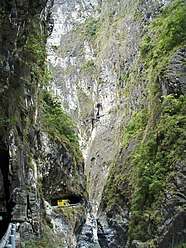Eight Views of Taiwan
The Eight Views of Taiwan (Chinese: 臺灣八景) have been talked about at different times in Taiwan's history.[1]

Taroko Gorge
Qing Dynasty
Under Japanese occupation
In 1927 (during Japanese occupation), the Taiwan Nichinichi Shimpō (Japanese: 臺灣日日新報) reported the Eight Views of Taiwan as:
- Rising Sun Hill (旭岡), now Sun Yat-sen Park, Keelung
- Tansui
- Eight Immortals Mountain
- Sun Moon Lake
- Alishan
- Ape Hill (now National Sun Yat-sen University)
- Cape Eluanbi
- Taroko
Republic of China
The earlier version of the Eight Views of Taiwan was defined by the Taiwan Provincial Government in 1953:
- Zintun (Sun Moon Lake in Thao language)
- Yushan (mountain)
- Fort Zeelandia (Taiwan)
- Alishan National Scenic Area
- Yangmingshan
- Taroko National Park
- Qingshui Cliff
- Penghu
The latest version of the Eight Views of Taiwan was defined by the ROC Ministry of Transportation in 2005 because of the change and transformation of the scenarios:
- Taipei 101
- National Palace Museum, Taipei
- Sun Moon Lake
- Alishan
- Yushan
- Kaohsiung Love River
- Kenting
- Taroko National Park
gollark: @MinerMan132 sorry, AFK.
gollark: This is my small-scale setup.
gollark: Why the mödem?
gollark: Cleveland.
gollark: I'm considering switching to a hex format.
References
- Eight Views of Taiwan (Baidu Encyclopedia) in Chinese
See also
- Eight Views in China, Japan and Korea
- Eight Views of Xiaoxiang
- Eight Views of Jinzhou (Dalian)
- Eight Views of Lushun South Road, Dalian
- Eight Views of Omi, Japan
- Eight Views of Korea
- Thirty-six Views of Mount Fuji, by Hokusai and Hiroshige
This article is issued from Wikipedia. The text is licensed under Creative Commons - Attribution - Sharealike. Additional terms may apply for the media files.